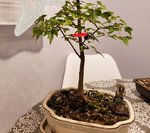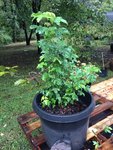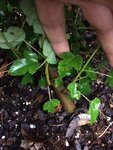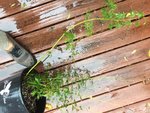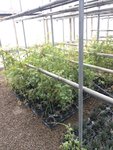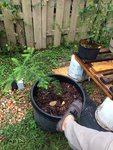My point was that trees that are grown slower and pruned often don't have large scars to heal. I have not even thought about slow V fast healing. I have seen some chops that over callus and produce ugly healing or inverse taper but not sure if that's from fast growth or even whether it is related to time of year chop.
All depends on the ultimate development and size of this tree. I agree that to convert this tree as it is to instant bonsai the chop would be below the 1st branch to allow a new canopy to grow. This would produce a very small bonsai - really neat but very difficult to maintain so not really practical for beginners (and this is clearly a beginner tree and beginner questions)
Cutting above the 1st branch just starts to set the bones for a future maple bonsai. The change of angle provides a bend in the new trunk. Tilt the whole tree to the right so the initial trunk is not straight up and informal upright trunk starts to emerge. Chopping also gives taper where that branch is clearly thinner than the trunk below. New buds will almost certainly grow on the trunk near the chop site - one of those will become a first branch. What is now the 1st branch is then the trunk. Allow it to grow freely all year to thicken the trunk then repeat a similar chop above a higher side branch to get a similar change of direction and more taper.
This basic process is repeated year after year on both the trunk and branches to develop trees with interesting changes of direction, good ramification and better taper. It will take time. Anyone with thoughts of quick deciduous bonsai should find another hobby or have deep pockets to pay someone else for the years of development.
COH has given another good option for this tree for a relatively small but quick bonsai. Many people are quite happy to have relatively thin bonsai and that cut will give more instant bonsai to work with. Allow all shoots to grow 5-8 pairs of leaves then prune back to 1 or 2 pairs as often as possible to develop a well ramified canopy. Trunk will stay relatively thin for many years but the tree should develop a nice canopy in 3-4 years and would keep many newbies quite happy.
There is rarely a single correct option for any bonsai. There are many bonsai hiding in this (and most other young) tree(s). Some will be quick, some slower, some impressive, some not so much.
Thank you for thoughts and experience. This seems to echo others I appreciate greatly for their knowledge and conveyance of such practice. Bjorn for example or folks here -scarless deciduous trunk should be revered and prioritized over the quick fat chop n’ dirty often associated with present western/American bonsai...
I have been putting more things into pots knowing others perhaps would not due to a lack of “development”, and thus far have not regretted any of those instances, even with the knowledge of how it will slow down the tree at hand. Thanks seriously for reminding that part of that slowing down can be to ones advantage beyond simply being in a pot now, which itself does sure have advantages in just how a tree is appreciated and able to be observed.
However, while I personally would prefer a naturally slender elegant trunk to some sumo triangle on a triangle, aren’t there advantages to growing things out in a larger vessel with intent, purpose, and attention to refinement in both quality and aesthetic? In other words, could you not have your cake and eat it too, then slow it down in the not so distant present? Do you aim to put a deciduous tree in a pot as soon as possible? Do you have trees in development not in bonsai pots?
It is common to see virtually any random practioner (professional) on say, bonsai empire for example, work on material not in a pot. That said “in an pot” would also be common as well (b empire etc..) as is the OP’s tree -especially regarding tree is close to the relative thickness as the rim of the pot, no slight on the material or vision ahead, I have one trident pictured above.
I guess the second thought I put forth is my trident (obviously much different than the circumstances of the op) that I put in a large nursery can has without really “thickening” in such little time, has had a lot of backbuding without any chop as of yet, or removal of upper biomass, that potentially if left will strengthen the tree and get lower branching (as is still happening) within one year without a single cut of leaf or branch. This is partly why I put it in a large pot and not the ground, for the new branch that will be the leader, not the trunk or existing branch on it, and it worked. I did this with this intention because two other Japanese maples I did the same with have thrown lower branches without a cut.
Regarding the op and myself because I’m new to it, I don’t think thread grafting is as daunting as it seemed to me at the beginning of this year and prior.
Mine will likely go into a pot sooner than maybe others would, or out of that huge nursery can and revised soil.
I am worried about scarring in fast development. What makes that lip get grotesque?
Thanks





